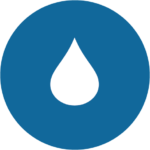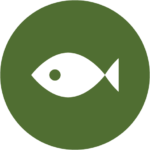State of the Lake Summary
Lake Segments
It is often said that Lake Champlain is not one lake, but several water bodies joined together. Unique characteristics of different parts of the Lake and the landscape that surrounds it make it challenging to easily summarize the state of the Lake. For this reason, scientists have used five distinct segments since the 1970s to describe the major regions of the Lake: Missisquoi Bay, Northeast Arm, Malletts Bay, Main Lake, and South Lake.
Missisquoi Bay
This shallow bay spans Québec and Vermont and is fed by the Missisquoi, Pike, and Rock Rivers. The bay contains less than 1% of the Lake’s total volume but 7% of the Lake’s surface area. Venise-en-Québec and other towns on the bay rely heavily on the health of Missisquoi Bay for their tourism industry. Elevated nutrient concentrations and seasonal release of legacy phosphorus from lake sediments contribute to frequent cyanobacteria blooms in warm months, inhibiting recreation opportunities and other uses of the Lake.
Northeast Arm
Located entirely within the state of Vermont, the Northeast Arm holds about 13% of the Lake’s volume. This relatively deep Lake segment is dotted with many islands, bays, and shallower areas, creating a favorite area for many boaters and anglers. St. Albans Bay, a large and productive bay, has frequent challenges with cyanobacteria blooms. A small population of invasive water chestnut is successfully managed in this bay.
Malletts Bay
A large, deep bay, Malletts Bay offers a mix of cold- and cool-water fishing and serves as a recreation hub for sailing and other boating activities. Over the past 10 years, phosphorus concentrations in this Lake segment have been just above the phosphorus limit, and cyanobacteria blooms are infrequent. The bay is home to one of the busiest public launches on Lake Champlain, creating a need for increased aquatic invasive species spread prevention work.
Main Lake
This is the largest segment of the Lake, containing about 85% of the Lake’s total volume. The water quality in this segment is generally excellent, offering plentiful recreation opportunities, angling for cold-, cool-, and warm-water fish, and a high quality drinking water supply for many Lake Champlain Basin residents. Cyanobacteria blooms appear here only occasionally. This segment also offers many historic interpretation opportunities, from shipwrecks in the Lake to historic forts on the hillsides.
South Lake
The South Lake is narrow, shallow, and markedly different from the rest of Lake Champlain. This area is known for scenic views and biological diversity. A number of native mussel species are found here, and the Poultney River system provides crucial habitat and large wetland complexes along the river. Consistent support for invasive water chestnut management in the South Lake continues to yield gains in reducing stress on the aquatic plant community and local recreation.
LCBP Goals
Four goals outlined in the 2017 version of the Lake Champlain management plan Opportunities for Action—clean water, healthy ecosystems, thriving communities, and an informed and involved public—serve as the framework for much of the LCBP’s work, including the 2021 State of the Lake and Ecosystems Indicators Report. The report presents the most recent information on the conditions of Lake Champlain and its watershed and highlights the results of some of the management actions taken to achieve the four goals.
Clean Water
 In most parts of Lake Champlain water quality remains good, however the Lake does not meet Clean Water Act goals for all uses. Fortunately, despite current water challenges the Lake continues to provide quality drinking water, and water-based recreation remains available to residents most of the time. Still, cyanobacteria blooms impact recreation during the summer months, especially where phosphorus levels remain too high and in other areas when warm weather persists. Some beaches are occasionally closed due to too much bacteria, typically following large storm events. Lake-wide, fish consumption advisories remain in place due to mercury, a problem in lakes across the Northeast, and chloride levels are increasing but remain well below the point of impacting drinking water quality. Municipalities are upgrading combined sewer systems to reduce the occurrence of overflows, which can send pathogens from untreated waste into the Lake.
In most parts of Lake Champlain water quality remains good, however the Lake does not meet Clean Water Act goals for all uses. Fortunately, despite current water challenges the Lake continues to provide quality drinking water, and water-based recreation remains available to residents most of the time. Still, cyanobacteria blooms impact recreation during the summer months, especially where phosphorus levels remain too high and in other areas when warm weather persists. Some beaches are occasionally closed due to too much bacteria, typically following large storm events. Lake-wide, fish consumption advisories remain in place due to mercury, a problem in lakes across the Northeast, and chloride levels are increasing but remain well below the point of impacting drinking water quality. Municipalities are upgrading combined sewer systems to reduce the occurrence of overflows, which can send pathogens from untreated waste into the Lake.
Healthy Ecosystems
 The Lake Champlain Basin provides habitat for thousands of native species, including more than 70 species of threatened and endangered fish and wildlife. However, climate change, invasive species, and pressures from human activities all threaten the health of the Basin’s ecosystem. Successful wild lake trout reproduction has allowed for the reduction of stocking of this species to maintain a balance of predators and prey in the Lake. Aquatic passage restoration has provided gains for Atlantic salmon habitat, but many systems remain fragmented. Wounding of lake trout by sea lamprey remains above targets, but Atlantic salmon are near target rates. Lake Champlain freezes over much less often than it did in the recent past, causing ecosystem effects that are not fully understood. Efforts to reduce the introduction of new invasive species have been successful, but established populations continue to do harm, and new threats require vigilance. Impacts from invasive water chestnut have decreased significantly following effective management.
The Lake Champlain Basin provides habitat for thousands of native species, including more than 70 species of threatened and endangered fish and wildlife. However, climate change, invasive species, and pressures from human activities all threaten the health of the Basin’s ecosystem. Successful wild lake trout reproduction has allowed for the reduction of stocking of this species to maintain a balance of predators and prey in the Lake. Aquatic passage restoration has provided gains for Atlantic salmon habitat, but many systems remain fragmented. Wounding of lake trout by sea lamprey remains above targets, but Atlantic salmon are near target rates. Lake Champlain freezes over much less often than it did in the recent past, causing ecosystem effects that are not fully understood. Efforts to reduce the introduction of new invasive species have been successful, but established populations continue to do harm, and new threats require vigilance. Impacts from invasive water chestnut have decreased significantly following effective management.
Thriving Communities
 Nearly 40% of the land area in the Lake Champlain Basin is conserved to some extent, providing ample recreational opportunities. The COVID-19 pandemic reinforced the need for conserved lands and public spaces—public trail systems, boat launches, and other outdoor recreation spaces saw a significant increase in use, to the point where New York State has enacted a system to address overcrowding. LCBP and partners have been working to ensure inclusion of traditionally underserved and Indigenous communities in Lake-related programs across the Basin. The LCBP acknowledges the history and culture of Indigenous people of the Basin and recognizes that we are all stewards of our natural and cultural resources.
Nearly 40% of the land area in the Lake Champlain Basin is conserved to some extent, providing ample recreational opportunities. The COVID-19 pandemic reinforced the need for conserved lands and public spaces—public trail systems, boat launches, and other outdoor recreation spaces saw a significant increase in use, to the point where New York State has enacted a system to address overcrowding. LCBP and partners have been working to ensure inclusion of traditionally underserved and Indigenous communities in Lake-related programs across the Basin. The LCBP acknowledges the history and culture of Indigenous people of the Basin and recognizes that we are all stewards of our natural and cultural resources.
Informed and Involved Public
 Watershed education efforts have reached many learners of all ages throughout the Lake Champlain Basin, developing future stewards of our water resources. During the 2018–2020 time period, boat launch stewards reached more than 192,000 boaters at public boat launches with messaging related to invasive species and other water quality issues. The LCBP Resource Room connected in person with more than 70,000 visitors during this same period. New programs target specific focus areas, such as residential lawn care for water quality or field trip opportunities for students. The COVID-19 pandemic created new opportunities to develop virtual programs, which allowed for broader reach to wider audiences and which will likely continue.
Watershed education efforts have reached many learners of all ages throughout the Lake Champlain Basin, developing future stewards of our water resources. During the 2018–2020 time period, boat launch stewards reached more than 192,000 boaters at public boat launches with messaging related to invasive species and other water quality issues. The LCBP Resource Room connected in person with more than 70,000 visitors during this same period. New programs target specific focus areas, such as residential lawn care for water quality or field trip opportunities for students. The COVID-19 pandemic created new opportunities to develop virtual programs, which allowed for broader reach to wider audiences and which will likely continue.

